Do you fancy a mini meadow garden?
People are increasingly interested in allowing part of their lawn to grow wild, because it looks beautiful and can help wildlife. there’s increasing interest in natural-looking meadow lawns.
Unlike the London Olympics, a middle-sized garden doesn’t have half a mile to fill with meadow flowers and native grasses. So is a mini meadow viable?
Amanda and Julian Mannering have a square walled garden behind their terraced house (open at the end of June every year for Faversham Open Gardens & Garden Market Day). It’s about 50ft x 60ft – space for borders all round, but not quite enough space to break up in any other way. They had a standard square lawn in the middle, but they weren’t entirely happy with it.
One day a friend stood in the middle and asked ‘what’s this lawn for?’
A meadow garden breaks up the space
So Julian and Amanda decided to turn the middle of the lawn into a mini meadow.
At first, they just mowed out the shape (around 30ft x 30ft square), with a path diagonally through the middle. Then they simply stopped mowing that area.

Friends told them that would never work, and that they would have to remove the turf.
Or you can just let the grass grow…
But I have about half a dozen friends with mini meadow gardens. None of them ‘did it properly.’ They all just let the grass grow. But it’s worth knowing that these are all perennial meadows. An annual meadow would need the soil to be cleared.
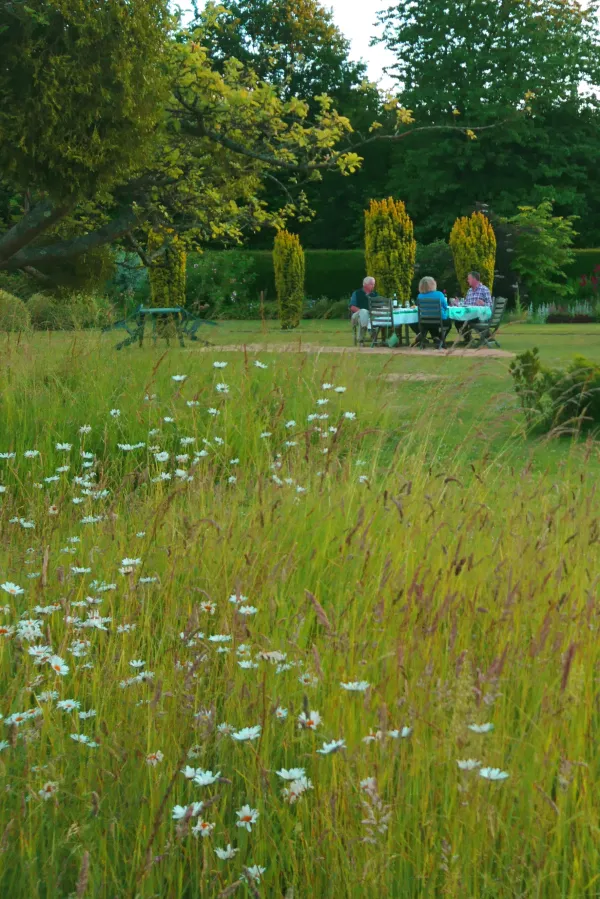
When conceptual artist Helen Kirwan let her lawn grow long, she never added seeds or plug plants. Ox-eye daisies ‘came from nowhere,’ she says.
However Amanda and Julian did do some meadow planting over the years: ‘We added some wildflower seeds from Emorsgate Seeds, and watched it all grow up.’ Emorsgate Seeds sell a variety of different meadow seeds for various soil types.
The first year Amanda and Julian mainly saw cowslips and wild carrot emerge, but a wildflower meadow changes every year. The wild carrot seems to have almost disappeared.
You still have to weed a mini meadow garden
Some weeds are very invasive, such as medick, docks, thistles and dandelions.
You will have to weed them out of your meadow garden regularly or they will take over.

Sow yellow rattle to weaken the grass
In the second year, Amanda and Julian sowed yellow rattle to weaken the grass, and this has proved to be very good advice. (They should really have sown it in the first year, but luckily nature doesn’t read instructions…)
Sarah Raven says that ‘sowing yellow rattle is the key to a mini meadow.’ That’s because it’s a parasitic plant, and will help reduce the amount of lawn grass you have. More wildflowers can establish themselves in the gaps.
A friend recently asked me why her own mini-meadow seemed to be flopping over with flattened grass. She too had simply allowed lawn turf to grow long. It was too thick and rich. I advised her to add yellow rattle to thin it out.
Joel Ashton specialises in installing wildlife friendly and eco friendly gardens. He says that traditional lawns are often too rich and vigorous like my friend’s lawn. The meadow flowers will struggle to get established in the luscious grass. He recommends planting 9cm plug plants rather than sowing seeds or planting seedlings. If you’ve been struggling to create a patch of mini meadow lawn, then see this post on common meadow lawn mistakes.
Add flowers as well as letting them grow
Amanda’s sister-in-law also gave her half a dozen ox-eye daisies (Leucanthemum vulgare) from her own meadow lawn. These have since multiplied into thousands.
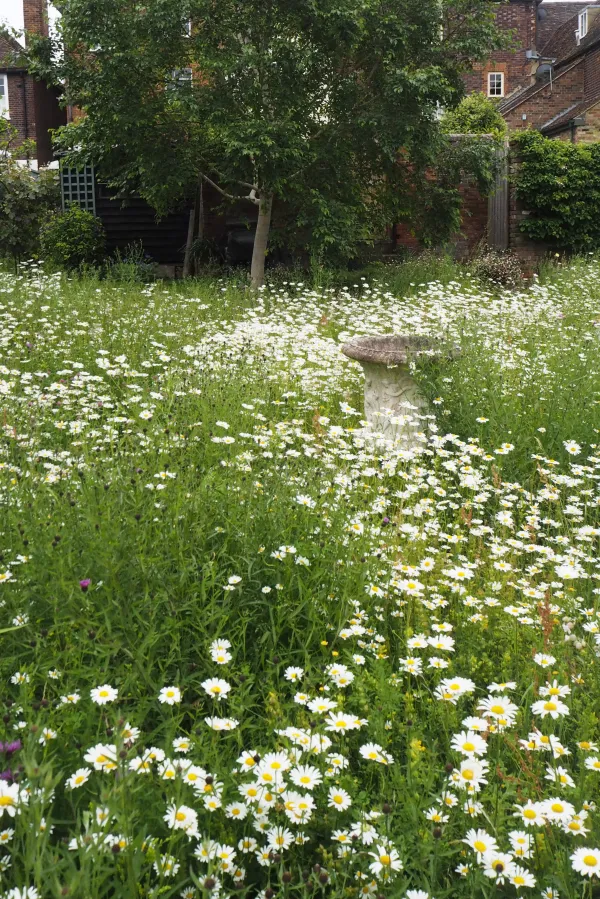
You can get 25 plug plants online from Kiss-my-Grass (Boston Seeds) for £29.50+ delivery.
Amanda and Julian also sowed wild grass seeds, too, to make the original grass more diverse.
So is a meadow garden less work?
Julian and Amanda spend much less time mowing the lawn. ‘It takes about twenty minutes to mow the paths once a week,’ said Amanda. That’s much less time than they spent mowing when the whole garden was a traditional lawn.
But there’s also the weeding, plus – in the early days only – some planting of seeds or appropriate meadow plants.
And they scythe it once a year, usually some time between mid-July and mid-August. ‘We went on a scything course. It takes about half an hour to do, and it’s all fairly easy once you know how. Then you remove the scythed material – don’t leave it lying on the ground or it will add nutrients.’
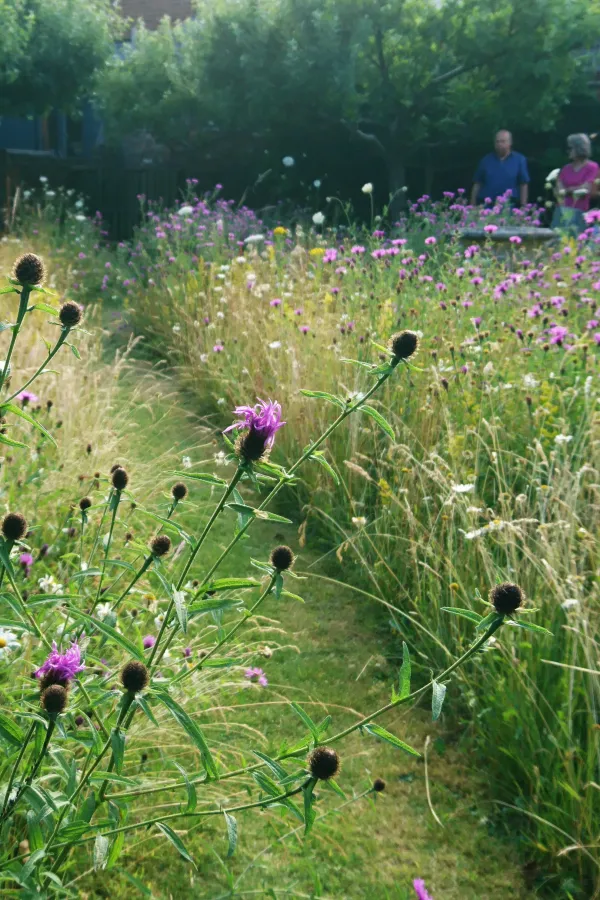
‘I also rake it occasionally in the winter. Generally, it is a bit less work,’ assessed Amanda. ‘But it’s a different sort of work, and done at different times.’
Every May, there is an initiative called ‘No Mow May’. Gardeners are urged not to mow for the month of May to provide food for emerging pollinators. If you’re on social media, use the hashtag #nomowmay to share your photos and experiences. (Find me on Instagram here.)
You can also do a partial mini meadow lawn simply by mowing less often. This is called a ‘nectar lawn’ rather than a meadow lawn. Instead of mowing weekly, you mow fortnightly, so that clover, daisies and other low flowers emerge for pollinators before the next mowing. I first heard about this when I interview head gardener of the Bath Priory Hotel, Jane Moore, author of Planting for Butterflies.
She has a meadow lawn at the Bath Priory, as well as a traditional lawn. She has noticed that the longer grass of the meadow lawn withstands drought better than the traditionally mown lawn. There’s more planting for butterflies and other wildlife advice from Jane here.
Which meadow plants to choose – perennial meadow or annual meadow?
The RHS explains that you need to decide whether you are going to grow a perennial meadow, like Amanda and Julian, or an annual meadow, like my friends who sow seeds every year.
The perennial meadow needs a fairly poor soil, so don’t enrich it. Amanda and Julian’s lawn was well drained, in full sun and hadn’t been fertilised so it was ideal for a perennial meadow, which comes up year after year.

The gate into Amanda and Julian’s perennial meadow lawn, with its ox-eye daisies in June.
Perennial meadow plants include ox-eye daisies and cowslips.
Annual meadows need richer soil, so they are the right choice if you’re replacing a border with a meadow. Plants for annual meadows include cornflowers, corn poppy, corn marigold and corncockle.
Lucy Chamberlain of the Cottage Garden School posted a video of the annual meadow garden she created. ‘On March 20th we rotavated, let it settle for two weeks, sowed, then raked it in. No watering. The seed was a blend of annual poppy, cornflower, corn marigold and corn chamomile. So incredibly easy to do.’

Amanda has tried to establish cornflowers in her meadow lawn, but so far they’ve failed. She thinks that the slugs have eaten them, but it may be that the soil isn’t rich enough, because cornflowers grow in an annual meadow and Amanda’s is a perennial meadow.
It’s worth remembering that an annual meadow has to be replanted every year, while a perennial meadow sorts itself out (up to a point).
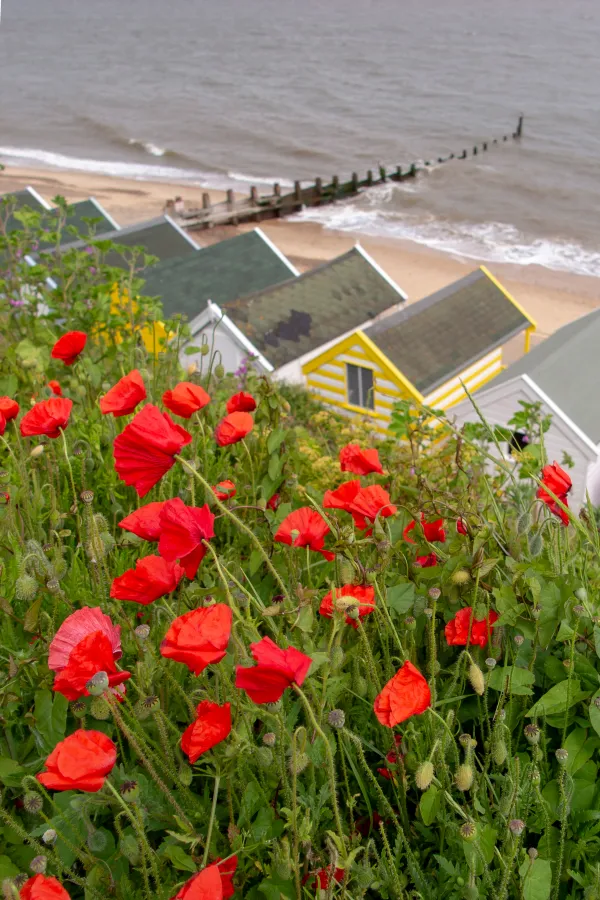
What about meadow gardens instead of flowers in borders?
Friends of mine grow wildflowers successfully in small raised beds. Former borders or raised beds are best for annual meadow plants because the soil is richer. You definitely need to start with clear, weeded soil, and an open sunny bed.
The results can be stunning – 3-4 months of changing colour, from an annual wildflower seed mix.
I hunted for annual wildflower and meadow seed mixes on Amazon. The most popular and best-reviewed was Plantworks 3 m Mini-meadow Easy Sow Wildflower Seed by Empathy. All the seeds are RHS approved ‘Perfect for Pollinators’.
And Empathy also make Rootgrow mycorrhizal fungi. This is a powder (endorsed by the RHS) which you scatter into the planting hole and which helps roots get established, improving take-up of nutrients and water. I’ve used Rootgrow on all my plantings this year, and so far everything is looking super-healthy.
Or try a ‘meadow effect border’
At BBC Gardeners World Live 2021, garden designer Tina Worboys won ‘Best Border’ for her meadow border. This was a mix of meadow flowers and cottage garden flowers that look like meadow flowers.

For example, she had cornflowers which are meadow flowers. And she mimicked cow parsley by using ammi, a similar looking flower.
The effect was very pretty and pollinator friendly. Tina grew all the plants herself from seed.
Should you buy plug plants?
Plug plants get your mini wildflower meadow off to a more definite start, as you can plan which plants to put in. The ones that do well in your area will do well, and others may not.
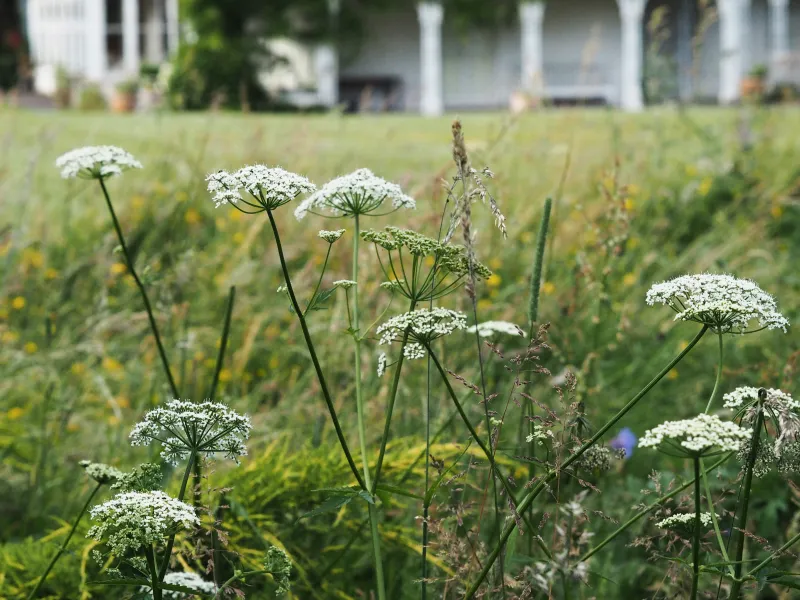
But at least the ones that do well will naturalise, so it should just be a one-off investment. Obviously, this is more expensive than seed.

However, in a small area, it’s relatively inexpensive and you’ll get a more instant effect.
Or wildflower meadow mats?
‘Meadow turf mats’ take alot of the guesswork out of growing a meadow. I found several companies who do this, including Turf Online and Wildflower Turf,
Can you plant a mini meadow anywhere?
The key is being in full sun and having well drained soil. Very shady corners aren’t suitable for a mini wildflower meadow.
There are meadow turf mats and wildflower seed mixes which will grow in dappled shade, but you have to specifically select them. For example, The Grass People have a shaded area meadow mix. You won’t be able to grow a meadow of any size in a very shady patch.
And Meadowmat have a Woodland Shade Wildflower Turf. It’s a pre-grown mat, costing £42 a square metre, of wildflowers, and grasses that are happy to grow in partial or dappled shade.
There are also other options if you don’t want a conventional lawn.
The delightful Abbey Physic Garden is also in Faversham Open Gardens & Garden Market Day. It has just planted small sections of chamomile lawn by a new bench, and is cultivating a small patch of ‘grass-free lawn’ on the other side. There are lots of wonderful wildflower or eco-gardening ideas at the Abbey Physic and it’s a beautiful garden to visit.
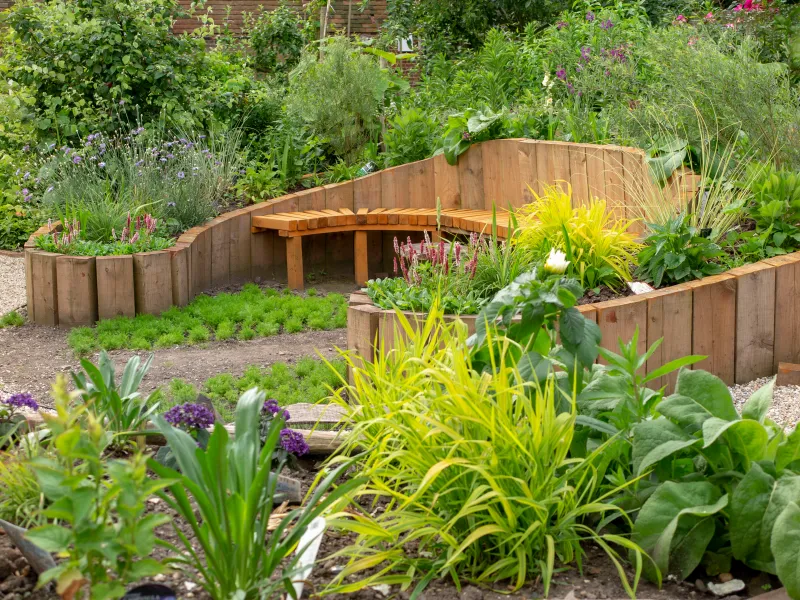
But a mini meadow lawn isn’t always the best option
We have two small patches of lawn in our front garden. I decided to experiment with turning these into a mini meadow lawn.
However, I didn’t want to dig the turf up and replace it. There are colonies of ground-nesting ivy mining bees in the lawn. It makes no sense to create a wildlife habitat by digging up a wildlife habitat.
So my only option was to let the turf grass grow. I added various bulbs which naturalise, such as wild tulips. And I threw wildflower seed into the lawn.
The wildflower seed didn’t take. As Joel Ashton explains in top meadow lawn mistakes, most turf grass is too vigorous. Simply throwing a load of wildflower seed into it is pointless. It will never get the chance to germinate and flourish.
The longer grass with bulbs looked in pretty in spring. In late spring, some lovely oxeye daisies appeared in the second year.
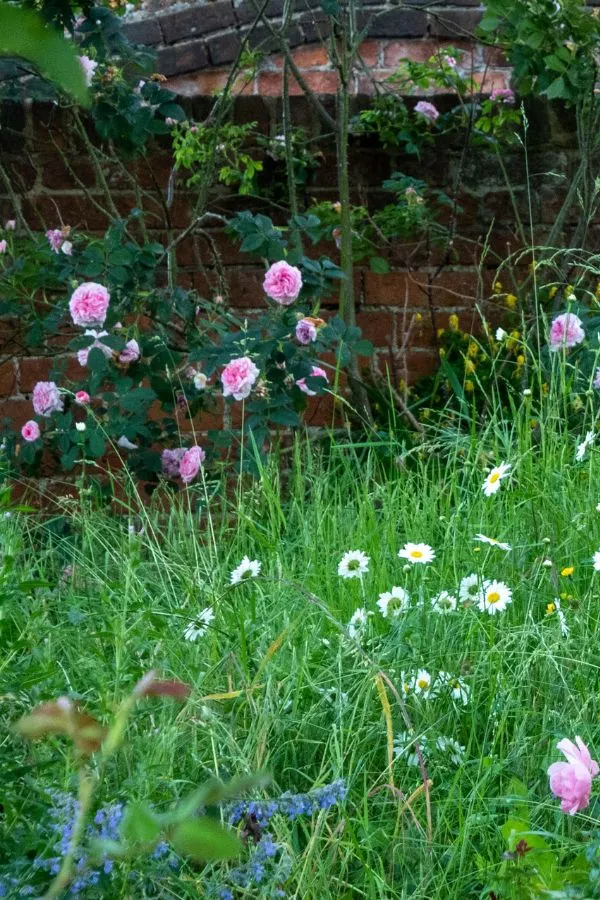
But it was less successful later on in summer. And in September, when the ivy mining bees emerge from the ground, it seemed as if there were far fewer than usual.
When I visited Great Dixter Gardens and spoke to their ecologist, I discovered why. Ivy mining bees need short grass to give them access to the soil! As Fergus Garrett of Great Dixter says in Gardening for Biodiversity, both short lawns and longer lawns can be helpful to wildlife. ‘Diversity is the key to biodiversity.’
Now we keep our front garden as a spring meadow lawn, but keep it short from mid-summer onwards.

Leave a Reply